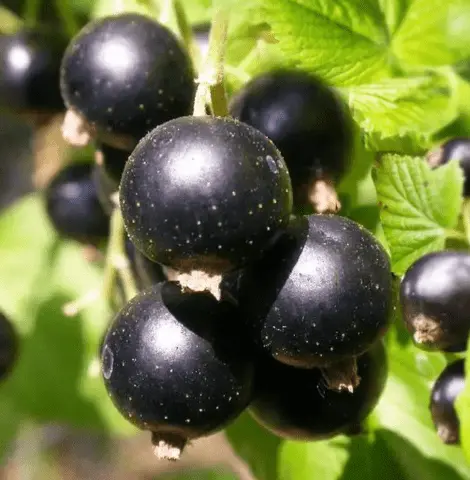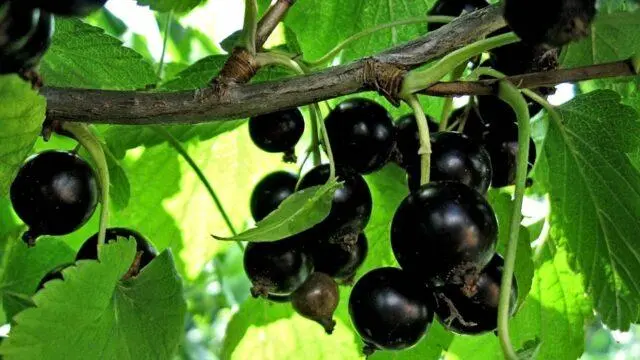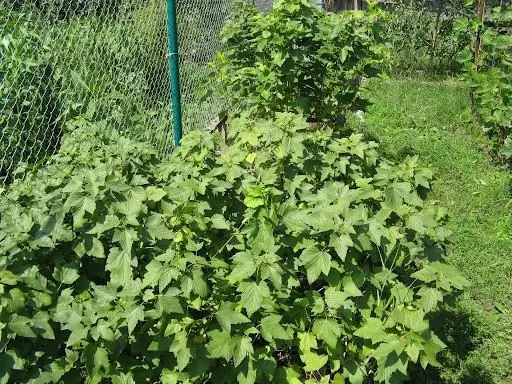Contents
Smorodina Sladkoplodnaya is a variety of Soviet selection, bred specifically for the regions of the Far East. Differs in the increased winter hardiness and stable productivity. Gives tasty berries of the average sizes of universal appointment. Suitable for fresh consumption and for preparations.
History of breeding
The blackcurrant variety Sweet-fruited was bred by Kuzmin A.Ya. over 60 years ago. The work was carried out on the basis of the Far Eastern Research Institute. Two lines were taken as a basis – Primorsky Champion and Goliath.
The culture was successfully tested, in 1959 it was registered in the register of breeding achievements. It is highly resistant to bud mites, as well as excellent winter hardiness.
Description of the currant variety Sweet-fruited
In the description of the sweet-fruited currant, different characteristics of the bush and fruits are given. The main parameters are shown below.
Bush
Blackcurrant bushes of this variety are medium-sized. The crown is moderately spreading. Shoots are small, straight, green, do not have pubescence. The leaves are classic, five-lobed, small in size, green in color. There are slight wrinkles on the surface. The blades are long, triangular.
The teeth are sharp, at the base of the currant leaf blade. A sweet-fruited notch of a small depth, open type is noticeable. Petioles are medium, green. The leaf scar has an open shape.
The flowers are small, cup-shaped, pinkish in color, while the sepals are light green in color, do not close. Brushes of currant Sweet-fruited are small, hanging down. Their petioles are short.
Berries
Fruits of a currant Sweet-fruited average sizes, weight reaches 0,6-0,7 g. Seeds contain not so much, Cups of the average sizes. The shape is round, the color is black.

Berries are sweet, ripen together
Characteristic of the variety
Among the characteristics of the variety of summer residents, they are most often interested in the indicator of winter hardiness, the taste of currants and productivity. The main parameters are described below.
Palatability
Currant variety Sladkoplodnaya gives quite juicy berries with a sweet and sour, refreshing taste. At the tasting, they received a score of 4,0 points out of 5. The composition contains:
- sugar – 6,6%;
- acids – 3,0%;
- vitamin C – more than 143 mg per 100 g of pulp.
The purpose of the fruits is universal, they can be used both fresh and for the preparation of preparations – jam, jam, fruit drink and others. Also, the berries of the Sladkoplodnaya currant variety are suitable for freezing. In this form, they retain almost all valuable substances, so they will bring maximum health benefits.
Terms of maturation
According to the ripening period, Sweet-fruited currant belongs to medium varieties. The fruits are massively formed in the second half of July, and ripen in the first decade of August. The separation is dry, which makes it easier to harvest. Once harvested, the berries can be stored in the refrigerator for 3-4 days. If there is a lot of harvest, it is better to immediately send it for freezing or processing.
Productivity
The yield of sweet-fruited blackcurrant is quite high and reaches 3-4 kg from 1 bush. Fruiting is generally stable, does not depend on the weather. To obtain a high yield, it is necessary to regularly water the bushes, loosen the soil and apply fertilizer.
Frost resistance
The frost resistance of the variety is very high, the bushes can withstand even severe frosts below -30 degrees. Therefore, they can be grown both in the Far East, but also in Siberia, as well as in neighboring regions.
Resistance to diseases
Blackcurrant Sweet-fruited has good resistance to bud mites. However, it can suffer from powdery mildew, anthracnose and septoria. Therefore, it is necessary to always monitor the rate of irrigation, to prevent waterlogging of the soil. It is also important to carry out preventive treatments in early spring, using fungicides and folk remedies.
Advantages and disadvantages
Blackcurrant Sweet-fruited is valued for its pleasant sweet taste, stable yield and, most importantly, for its high winter hardiness. This is one of the few varieties that can be grown in most regions of the Far East from Primorsky Krai to Kamchatka.

Each adult bush gives at least 3 kg of crop
Pros:
- stable yield;
- delicious berries;
- very high winter hardiness;
- can be grown even in regions with severe winters;
- resistance to kidney mites;
- self-fertile – no pollinators required.
Cons:
- no immunity to anthracnose;
- poor resistance to septoria, powdery mildew;
- fruits are quite small.
How to plant
It is better to start planting sweet-fruited currants in the spring – in early March, so that by the first winter the seedlings have already taken root in a new place. The landing site should be sunny, but at the same time closed from through winds – it is optimal to plant currant bushes next to the fence.
The soil should be not only fertile, but also sufficiently loose, with a slightly acidic reaction. Previously, it is dug up and fertilized with humus or compost – a bucket per square meter. If there is a lot of clay in the soil, close up sand or sawdust 3-5 kg each for the same area.
When landing, they act like this:
- Dig several holes with a depth of 60-70 cm at a distance of 1,5 m.
- A layer of small stones is laid at the bottom.
- They put the seedling in the center at an angle, sprinkle with soil.
- The soil is tamped so that the root neck is at a depth of 8 cm.
- Watered with settled water.
- All shoots are shortened, leaving 2-3 buds on each.
Features of care
Blackcurrant Sweet-fruited does not need special care. But to get a good harvest, it must be watered periodically. Young seedlings are given water weekly, adult bushes – twice a month, in the heat – more often.
In the spring, they fertilize with nitrogen compounds; during flowering and bud formation, superphosphate and potassium salt are added. Once a month, you can water with mullein 1:10 or chicken manure 1:20.

In summer, the bushes are watered as the soil dries out.
The earth is periodically loosened, weeding is done. In early spring, sanitary and formative pruning is planned. At the same time, it is necessary to carry out preventive treatment against pests, for example, Bordeaux liquid, Skorom, Maxim or other preparations.
Conclusion
Currant Sladkoplodnaya is one of the best varieties for the Far East and other regions with frosty winters. The yield is consistently high, the berries are tasty. It has good immunity, but can suffer from fungal diseases. Therefore, the bushes must be treated annually with fungicides.










